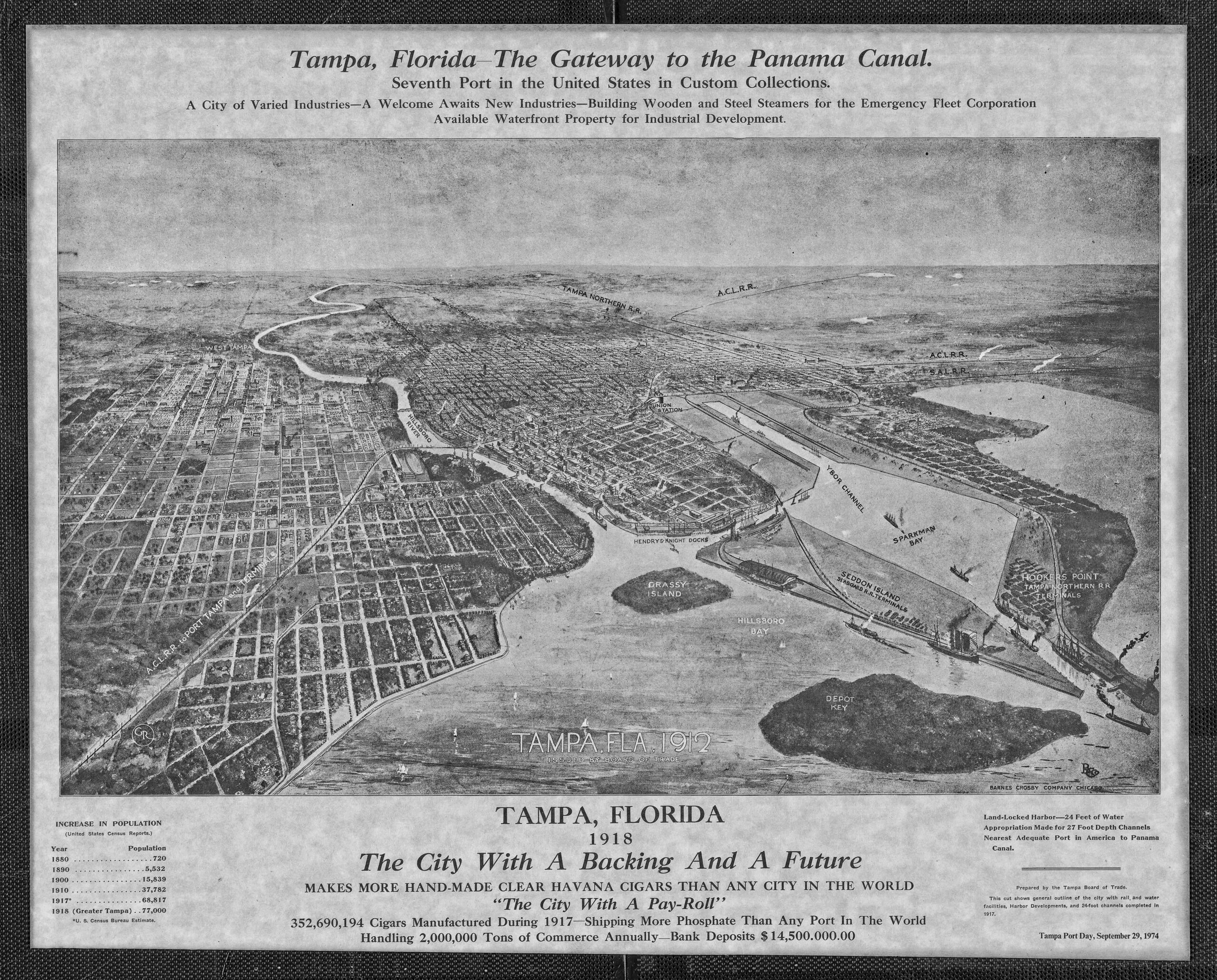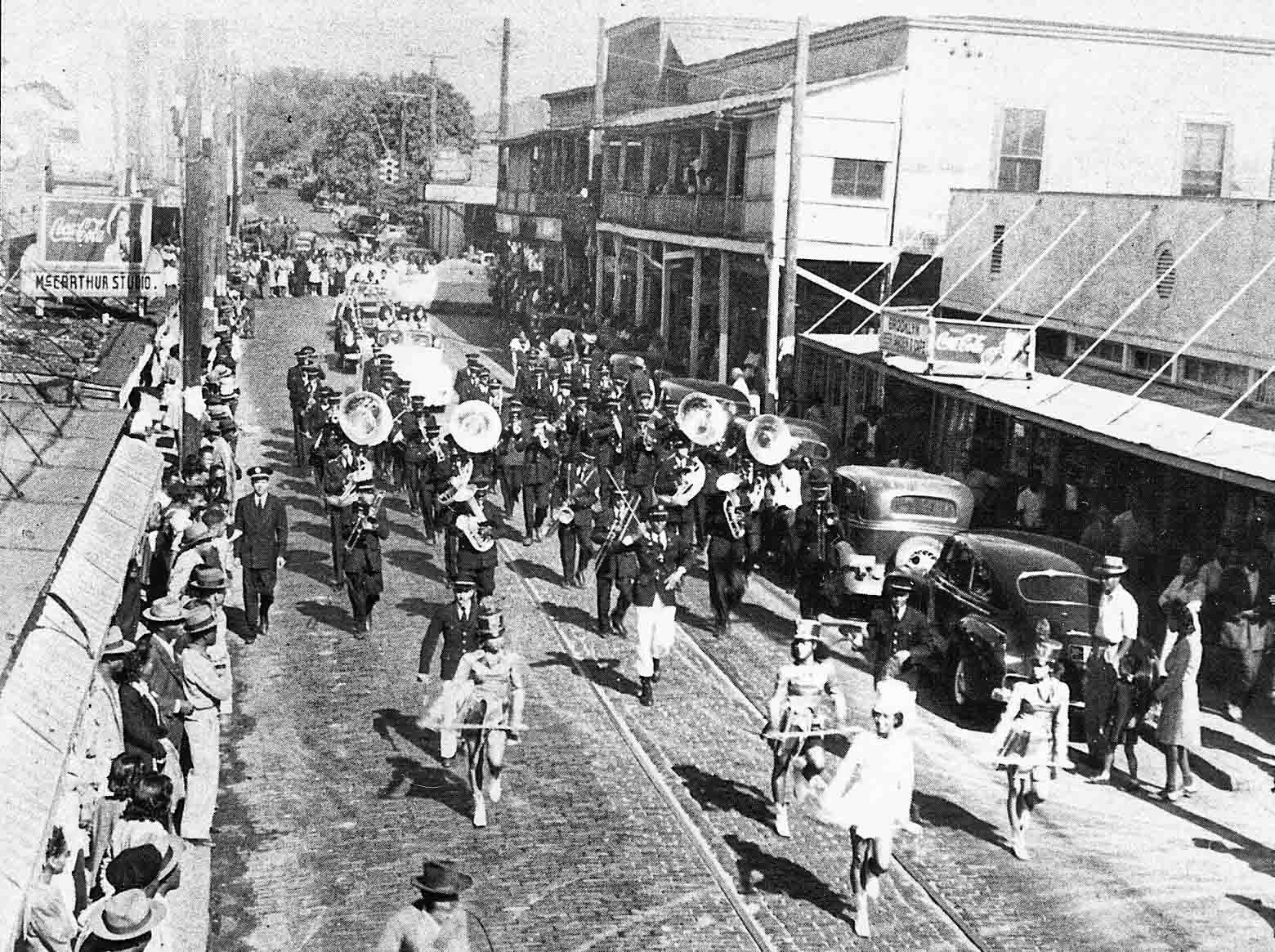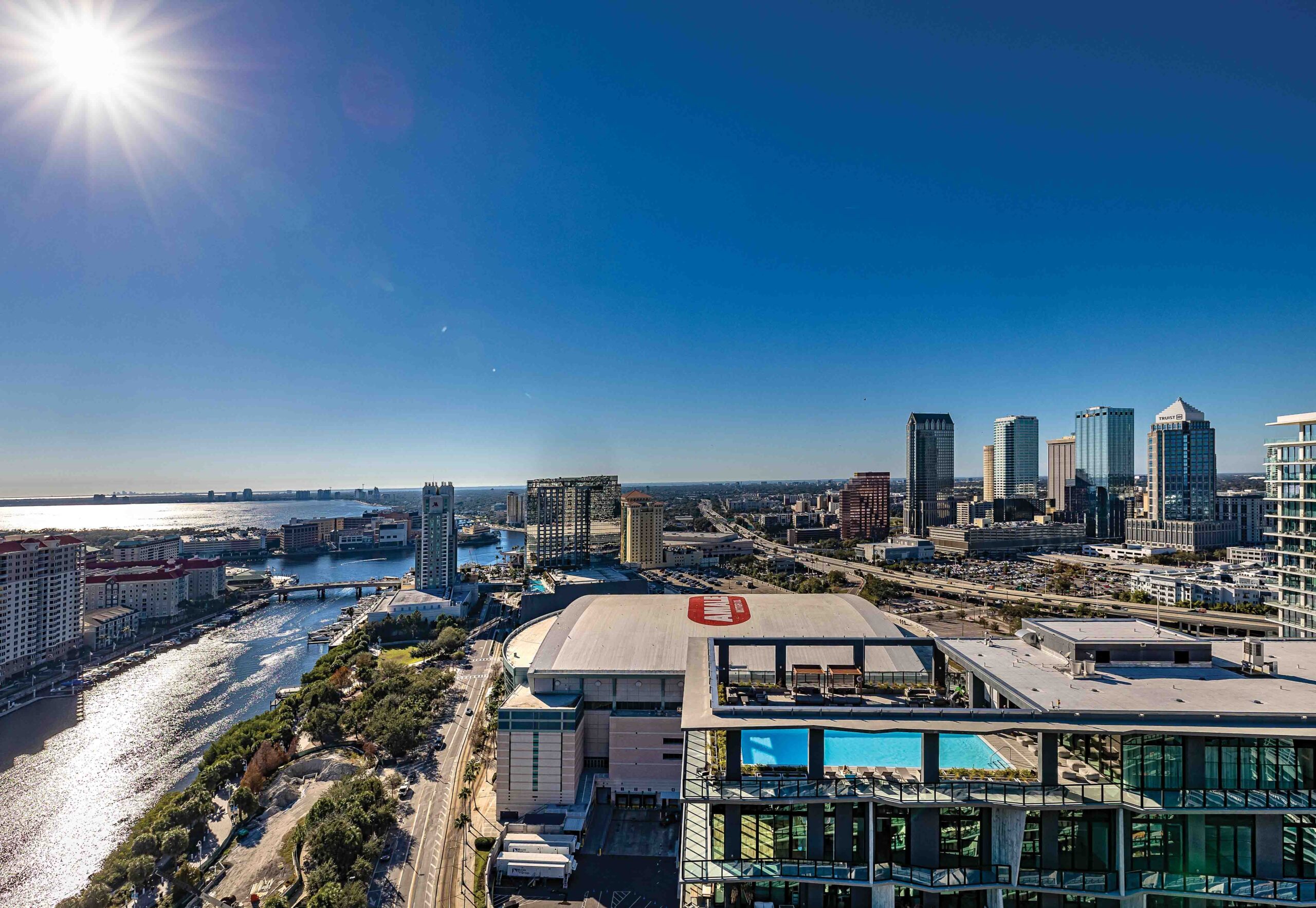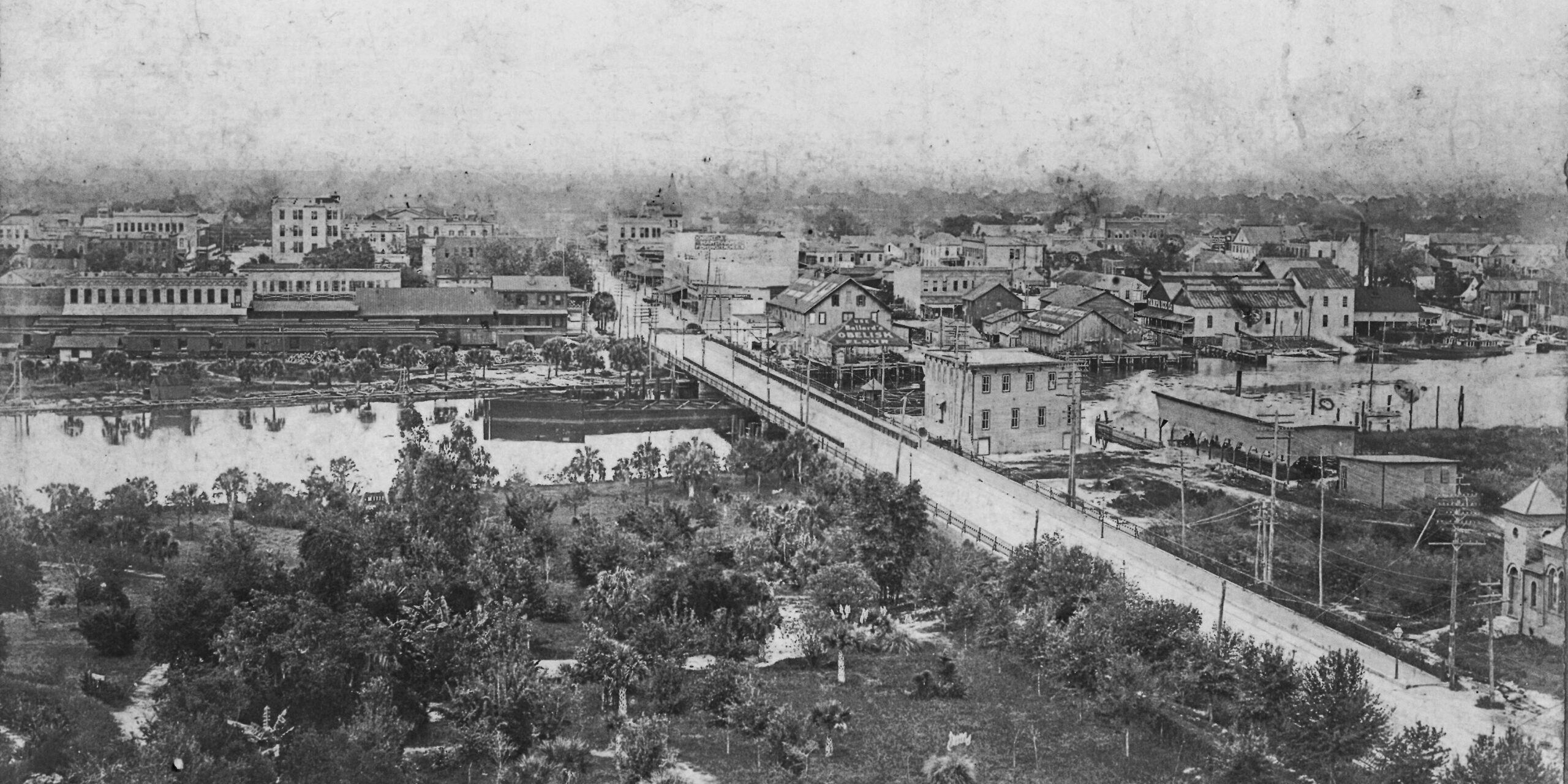Step into a captivating journey through time as we unveil the storied tapestry of Downtown Tampa’s history and evolution, woven over two centuries. Nestled within Tampa’s streets are rich stories of eras come and gone, all leaving their marks and contributing to the unique place Tampa is today. Each of these eras unveils the evolution of our compelling cityscape, now adorned with the footprints of visionaries who sculpted its destiny and made Tampa the place it is today. From its humble origins as a military outpost to the soaring skyline that now grows at breakneck speed, here is the history and story of our rising metropolis, Downtown Tampa.
1820’s
Fort Brooke Era
 Lithograph of Fort Brooke, dating from the early 1830s: The story of downtown Tampa begins, in many ways, with the establishment of Fort Brooke in January 1824. While people had lived in what is now downtown Tampa for thousands of years, the creation of the fort and the subsequent military activity surrounding the efforts to remove the Seminole Indians from Florida led directly to the founding of the Town of Tampa in the 1830s.
Lithograph of Fort Brooke, dating from the early 1830s: The story of downtown Tampa begins, in many ways, with the establishment of Fort Brooke in January 1824. While people had lived in what is now downtown Tampa for thousands of years, the creation of the fort and the subsequent military activity surrounding the efforts to remove the Seminole Indians from Florida led directly to the founding of the Town of Tampa in the 1830s.
1850’s
John Jackson’s Map of the Tampa Era
 Tampa (Map of Tampa, from the surveys of John Jackson, 1853): Surveyor John Jackson created his landmark map of Tampa in 1853. This is the earliest map to show the entire Town of Tampa as well as Fort Brooke. The dividing line between the two was Whiting Street, named by Jackson in honor of Major Levi Whiting who was the commander of the fort at this time. Note that most of the street names are the same today.
Tampa (Map of Tampa, from the surveys of John Jackson, 1853): Surveyor John Jackson created his landmark map of Tampa in 1853. This is the earliest map to show the entire Town of Tampa as well as Fort Brooke. The dividing line between the two was Whiting Street, named by Jackson in honor of Major Levi Whiting who was the commander of the fort at this time. Note that most of the street names are the same today.
1880’s
The Railroad and Phosphate Era
View of Downtown Tampa from the Tampa Bay Hotel, 1895 (photo featured above): Tampa’s growth was stunted throughout most of the 19th century. That changed in the early 1880s because of three important events: the arrival of Henry Plant’s railroad, the discovery of phosphate in the region, and the founding of the cigar industry. Between 1880 and 1890, Tampa’s population increased by almost 800% – from 720 to over 5,500. This view, taken from the then-new Tampa Bay Hotel, shows the small but growing city on the Hillsborough River.
Ybor City and Cigars Era
 Vicente Martinez Ybor Cigar Factory – The arrival of the cigar industry forever changed Tampa. The influx of workers, mostly Cubans but also Afro-Cubans, Spaniards, and later Sicilians, made Tampa the most diverse city in the south. The industry also brought a wide variety of ancillary businesses and jobs, from cigar box manufacturing to construction, farms, shopkeepers, and business, legal, and medical professionals. The Ybor factory still stands on 14th Street between 8th and 9th Avenues.
Vicente Martinez Ybor Cigar Factory – The arrival of the cigar industry forever changed Tampa. The influx of workers, mostly Cubans but also Afro-Cubans, Spaniards, and later Sicilians, made Tampa the most diverse city in the south. The industry also brought a wide variety of ancillary businesses and jobs, from cigar box manufacturing to construction, farms, shopkeepers, and business, legal, and medical professionals. The Ybor factory still stands on 14th Street between 8th and 9th Avenues.
Early 1900’s
The Port Era
 View of Downtown Tampa from the Tampa Bay Hotel, 1895: Tampa’s growth was stunted throughout most of the 19th century. That changed in the early 1880s because of three important events: the arrival of Henry Plant’s railroad, the discovery of phosphate in the region, and the founding of the cigar industry. Between 1880 and 1890, Tampa’s population increased by almost 800% – from 720 to over 5,500. This view, taken from the then-new Tampa Bay Hotel, shows the small but growing city on the Hillsborough River.
View of Downtown Tampa from the Tampa Bay Hotel, 1895: Tampa’s growth was stunted throughout most of the 19th century. That changed in the early 1880s because of three important events: the arrival of Henry Plant’s railroad, the discovery of phosphate in the region, and the founding of the cigar industry. Between 1880 and 1890, Tampa’s population increased by almost 800% – from 720 to over 5,500. This view, taken from the then-new Tampa Bay Hotel, shows the small but growing city on the Hillsborough River.
1880’s-1950’s
The Industrial Era
 Atlantic Coast Line Railroad Warehouse: Tampa’s downtown waterfront was heavily industrial from the 1880s through the 1950s. Railroad lines, wharves, and warehouses lined the riverfront, plus Garrison Channel and Ybor Channel. Slowly, beginning in the late 1950s, the industrial usage of the waterfront began to shift further east and south down Hillsborough Bay. Despite that shift, Tampa’s industrial waterfront is still a vital part of the region’s economy.
Atlantic Coast Line Railroad Warehouse: Tampa’s downtown waterfront was heavily industrial from the 1880s through the 1950s. Railroad lines, wharves, and warehouses lined the riverfront, plus Garrison Channel and Ybor Channel. Slowly, beginning in the late 1950s, the industrial usage of the waterfront began to shift further east and south down Hillsborough Bay. Despite that shift, Tampa’s industrial waterfront is still a vital part of the region’s economy.
1900’s-1950’s
The Streetcar and Retail Era
 Slice of Life on Franklin Street: Tampa’s Franklin Street, particularly the stretch between Lafayette (Kennedy) and Tyler, was the epicenter of city life from the early 1900s through the 1950s. This photo, taken in the 1920s, shows the hustle and bustle of the city, including the twin streetcars – known as a doubleheader. Most of the buildings shown here are gone, but the Exchange Bank Building, seen on the right side of the street toward the center of the photo, serves as an enduring landmark.
Slice of Life on Franklin Street: Tampa’s Franklin Street, particularly the stretch between Lafayette (Kennedy) and Tyler, was the epicenter of city life from the early 1900s through the 1950s. This photo, taken in the 1920s, shows the hustle and bustle of the city, including the twin streetcars – known as a doubleheader. Most of the buildings shown here are gone, but the Exchange Bank Building, seen on the right side of the street toward the center of the photo, serves as an enduring landmark.
1900-1960’s
The Central Avenue Era
 Parade on Central: Central Avenue served as the main business district for Tampa’s African American community during the era of segregation. An incredible variety of businesses – from bars to theaters to professional offices – lined Central Avenue from Scott Street to Cass Street. This photo shows a parade heading south on Central from Scott – much like parade organizers utilized Franklin Street downtown.
Parade on Central: Central Avenue served as the main business district for Tampa’s African American community during the era of segregation. An incredible variety of businesses – from bars to theaters to professional offices – lined Central Avenue from Scott Street to Cass Street. This photo shows a parade heading south on Central from Scott – much like parade organizers utilized Franklin Street downtown.
Kennedy Boulevard Westward Expansion Era
 Lafayette Street and Grand Central: Tampa’s business district extended a bit to the west, over the Hillsborough River, along Lafayette Street and onto Grand Central Avenue. A small portion of Grand Central still exists today, running along the south side of the triangular-shaped building that now houses Mise en Place and Oxford Exchange, among others. Lafayette Street and the western extension of Grand Central were renamed in honor of President John F. Kennedy soon after his assassination in 1963.
Lafayette Street and Grand Central: Tampa’s business district extended a bit to the west, over the Hillsborough River, along Lafayette Street and onto Grand Central Avenue. A small portion of Grand Central still exists today, running along the south side of the triangular-shaped building that now houses Mise en Place and Oxford Exchange, among others. Lafayette Street and the western extension of Grand Central were renamed in honor of President John F. Kennedy soon after his assassination in 1963.
1970’s-1990’s
Banking and Professional Services
 Franklin Street, looking west: Tampa was home to a variety of locally-owned banks throughout the first half of the 20th century. The Marine Bank & Trust Company occupied a small but stately building on Franklin Street until, in early 1962 when the bank’s new office tower was dedicated. That building, also on Franklin Street, is now the headquarters for the Tampa Police Department.
Franklin Street, looking west: Tampa was home to a variety of locally-owned banks throughout the first half of the 20th century. The Marine Bank & Trust Company occupied a small but stately building on Franklin Street until, in early 1962 when the bank’s new office tower was dedicated. That building, also on Franklin Street, is now the headquarters for the Tampa Police Department.
1980’s-2000’s
Harbour Island Neighborhood and Downtown Waterfront Era
 Garrison Channel and south end of downtown Tampa: Few places have undergone the amount of change that has been seen in the southern end of downtown Tampa over the past few decades. Beginning in the early 1980s, the waterfront has been transformed from an industrial, working waterfront to a place that draws thousands of tourists and residents every day. Numerous public projects, including the Riverwalk, Tampa Convention Center, Florida Aquarium, and Tampa Bay History Center, along with private investment in hotels, apartments, offices, and retail, have made the location of this photo nearly unrecognizable.
Garrison Channel and south end of downtown Tampa: Few places have undergone the amount of change that has been seen in the southern end of downtown Tampa over the past few decades. Beginning in the early 1980s, the waterfront has been transformed from an industrial, working waterfront to a place that draws thousands of tourists and residents every day. Numerous public projects, including the Riverwalk, Tampa Convention Center, Florida Aquarium, and Tampa Bay History Center, along with private investment in hotels, apartments, offices, and retail, have made the location of this photo nearly unrecognizable.
2000’s Through Today
Downtown Live, Work, Play Era
 Modern photo of downtown from the Water Street neighborhood supplied by Tampa Magazines: Today’s downtown Tampa is a vibrant place that reflects, in many ways, its history as the center of life in Tampa. Like many urban areas in the U.S. during the 1970s and ‘80s, downtown Tampa was populated almost solely by office workers who left for the suburbs after work. That has definitely changed, as Tampa’s urban core is now fulfilling the promise of a live-work-play location that is busy day and night.
Modern photo of downtown from the Water Street neighborhood supplied by Tampa Magazines: Today’s downtown Tampa is a vibrant place that reflects, in many ways, its history as the center of life in Tampa. Like many urban areas in the U.S. during the 1970s and ‘80s, downtown Tampa was populated almost solely by office workers who left for the suburbs after work. That has definitely changed, as Tampa’s urban core is now fulfilling the promise of a live-work-play location that is busy day and night.
Rodney Kite-Powell is a Tampa-born author, the official historian of Hillsborough County and the director of the Touchton Map Library at the Tampa Bay History Center, where he has worked since 1995.
To learn more about Tampa Bay’s history, check out the Prohibition Era. To find out how to advertise with us, click here.



